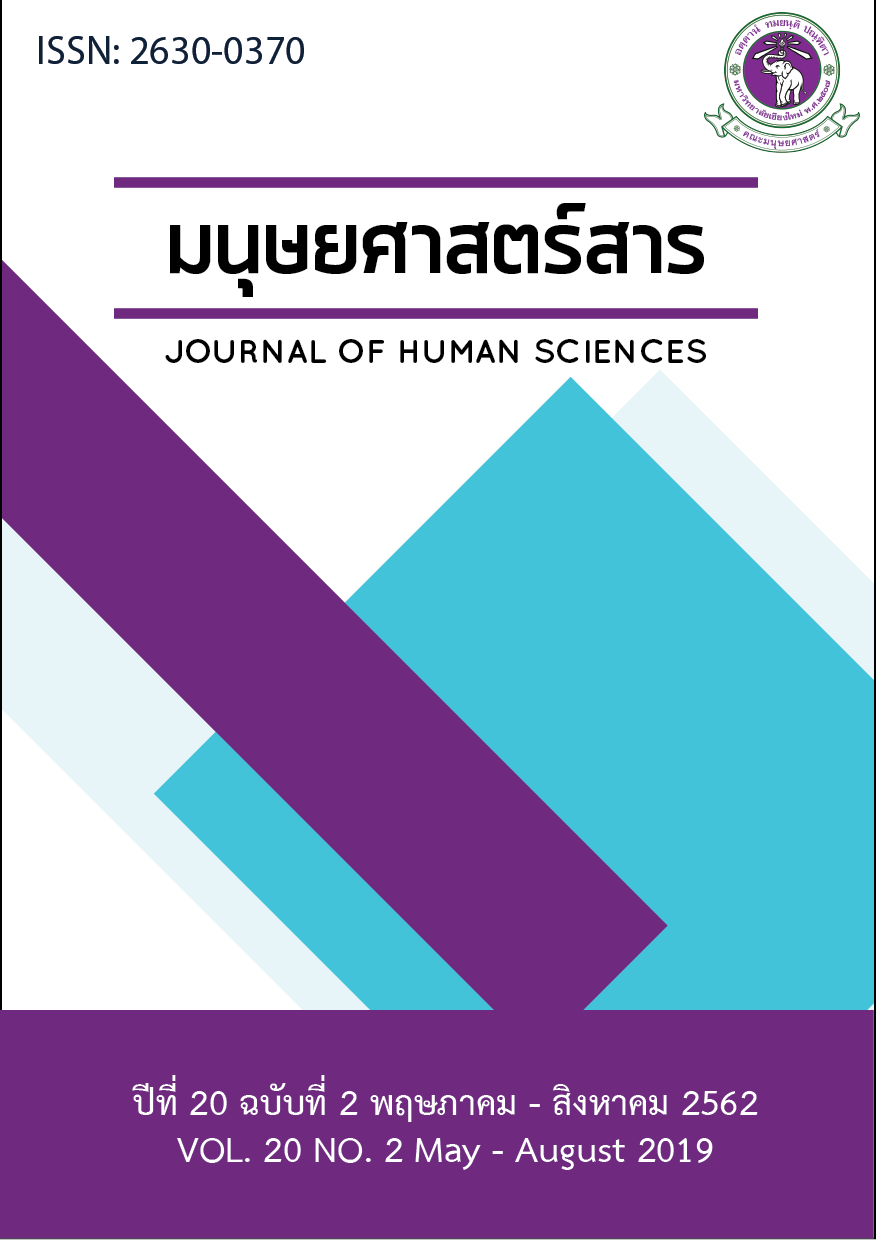การพัฒนาแผนการตลาดการท่องเที่ยวเชิงบูรณาการเพื่อสร้างให้จังหวัดเชียงรายเป็นจุดเชื่อมต่อการท่องเที่ยวของแหล่งอารยธรรมล้านนาผ่านพฤติกรรมนักท่องเที่ยวและการรับรู้สื่อประชาสัมพันธ์การท่องเที่ยว
Main Article Content
บทคัดย่อ
การวิจัยนี้มีวัตถุประสงค์ คือ 1) เพื่อศึกษาพฤติกรรมการท่องเที่ยวของนักท่องเที่ยวที่มีต่อความสัมพันธ์กับจุดเชื่อมต่อทางการท่องเที่ยวของอารยธรรมล้านนา 2) ศึกษาการรับรู้สื่อ
ประชาสัมพันธ์การท่องเที่ยวของนักท่องเที่ยวที่มีต่อความสัมพันธ์กับจุดเชื่อมต่อทางการท่องเที่ยวของอารยธรรมล้านนา 3) เสนอแนะแนวทางการพัฒนาสื่อประชาสัมพันธ์การท่องเที่ยวของนักท่องเที่ยวที่มีต่อความสัมพันธ์กับจุดเชื่อมต่อทางการท่องเที่ยวของอารยธรรมล้านนา และ 4) พัฒนาแผนการตลาดการท่องเที่ยวเชิงบูรณาการ ในการสร้างให้จังหวัดเชียงรายเป็นจุดเชื่อมต่อการท่องเที่ยวของอารยธรรมล้านนา ดำเนินการวิจัยด้วยวิธีวิจัยแบบผสม โดยการทบทวนวรรณกรรม การสัมภาษณ์และการสำรวจความคิดเห็นจากนักท่องเที่ยวชาวไทยจำนวน 400 คน และชาวต่างชาติจำนวน 400 คน ผลการวิจัยพบว่า พฤติกรรมการท่องเที่ยวของนักท่องเที่ยวที่มีต่อความสัมพันธ์กับจุดเชื่อมต่อทางการท่องเที่ยวของอารยธรรมล้านนา ที่เดินทางมาท่องเที่ยวในจังหวัดเชียงรายส่วนใหญ่เป็นเพศหญิง โดยนักท่องเที่ยวชาวไทยส่วนมากเป็นนักศึกษา นักท่องเที่ยวชาวจีนส่วนใหญ่เป็นนักธุรกิจ ทั้งสองกลุ่มนี้อยู่ในช่วงวัยที่เรียกว่า เจเนอเรชัน วาย ส่วนนักท่องเที่ยวชาวต่างชาติที่ไม่ใช่ชาวจีนส่วนใหญ่เป็นพนักงานในบริษัทเอกชนอยู่ในช่วงวัย เจเนอเรชัน เอกซ์ นักท่องเที่ยวส่วนใหญ่เดินทางท่องเที่ยวด้วยตนเองจากต้นทางคือ จังหวัดเชียงใหม่และกรุงเทพมหานคร เลือกพักในเขตตัวเมืองจังหวัดเชียงรายมีจุดประสงค์การเดินทางโดยรวมคือเพื่อความสนุกสนาน ความบันเทิง พักผ่อนร่างกายและสมอง
ในขณะที่นักท่องเที่ยวชาวต่างชาติที่ไม่ใช่ชาวจีน มีจุดประสงค์เพื่อศึกษาวัฒนธรรมและหาความรู้รวมอยู่ด้วย ส่วนการรับรู้สื่อประชาสัมพันธ์การท่องเที่ยวของนักท่องเที่ยวที่มีต่อความสัมพันธ์กับจุดเชื่อมต่อทางการท่องเที่ยวของอารยธรรมล้านนา พบว่า สื่อประชาสัมพันธ์ที่มีอิทธิพลต่อการตัดสินใจเดินทางมาท่องเที่ยวของนักท่องเที่ยวโดยรวมคือ “ตัวบุคคล”รองลงมาคือสื่อเว็บไซต์และการบอกต่อแบบปากต่อปาก โดยเนื้อหาในสื่อประชาสัมพันธ์ต้องมีความเข้าใจง่ายและความดึงดูดใจ การเชื่อมต่อกันของประสบการณ์ในระหว่างการเดินทางท่องเที่ยวนั้นเกิดการส่งต่อประสบการณ์ด้วยลักษณะทางวัฒนธรรมที่มีความเชื่อมโยงกันจากแหล่งท่องเที่ยวหนึ่งไปสู่อีกแหล่งท่องเที่ยวหนึ่ง โดยเฉพาะพบเห็นและได้เรียนรู้วิถีชีวิตความเป็นอยู่ของผู้คนภายในท้องถิ่น ด้วยการคมนาคมเข้าถึงแหล่งท่องเที่ยวที่สะดวก สบาย ปลอดภัยสำหรับเสนอแนะแนวทางการพัฒนาสื่อประชาสัมพันธ์การท่องเที่ยวของนักท่องเที่ยวที่มีต่อความสัมพันธ์กับจุดเชื่อมต่อทางการท่องเที่ยวของอารยธรรมล้านนา พบว่า การประชาสัมพันธ์การท่องเที่ยวแบบเชื่อมโยงประสบการณ์การท่องเที่ยวได้มากกว่า 1 แหล่ง และแนะนำสินค้าเด่นของท้องถิ่นที่จะทำให้นักท่องเที่ยวตัดสินใจซื้อสินค้าท้องถิ่นนั้นๆ ได้ และการพัฒนาแผนการตลาดการท่องเที่ยวเชื่อมโยงอารยธรรมล้านนาของจังหวัดเชียงรายควรมุ่งเน้นสัมผัสประสบการณ์อารยธรรมล้านนาแบบหลากหลายทั้งในจังหวัดเชียงราย กลุ่มจังหวัดทางภาคเหนือและประเทศเพื่อนบ้าน ด้วยกลยุทธ์สร้างประสบการณ์การท่องเที่ยวอารยธรรมล้านนาและความแตกต่าง ทั้งในด้านกิจกรรมทางการตลาดการสร้างเครือข่ายเชื่อมโยงเส้นทางประสบการณ์ท่องเที่ยวอารยธรรมล้านนา การกำหนดราคาอย่างมีศิลปะในการรวบรวมชุดการท่องเที่ยว จัดจำหน่ายผ่านเว็บไซต์และระบบปฏิบัติการโทรศัพท์เคลื่อนที่ ส่งเสริมการตลาดผ่านกิจกรรมประสบการณ์ทางอัตลักษณ์วัฒนธรรมแห่งอารยธรรมล้านนาและจุดเชื่อมโยงการท่องเที่ยวเมืองห้าเชียง
Article Details
เอกสารอ้างอิง
Cooper, C. (2012). Essentials of Tourism. London: Financial Times Press.
Ministry of Tourism & Sports, Department of Tourism. (2011). ASEAN Tourism Strategic Plan 2011-2015. Jakarta: ASEAN Secretariat.
Ministry of Tourism & Sports, Department of Tourism. (2016). Situation to Domestic Traveler, Chiang Rai Province: 2009 - 2015. Retrieved From https://www.chiangrai.net/dashboard19/
Ministry of Tourism & Sports. (n.d.). yutthasat krasuang kanthongthieo læ kila Pho.So. songphanharoihasipha – songphanharoihasipkao. Retrieved from https://www.mots.go.th/ewt_dl_link.php?nid=3942
Office of the National Economics and Social Development Council. (2008) National Economics and Social Development Plan No. 4. Retrieved From https://www.nesdb.go.th/Default.aspx.
Office of the National Economics and Social Development Council. (2016) National Economics and Social Development Plan No. 12 (2017-2021). Retrieved From https://www.nesdb.go.th/ewt_dl_link.php?nid=6422.
Parnwell, M. J. G. (2001). Sinews of interconnectivity: tourism and environment in the Greater Mekong Subregion. In P. Teo, T. C. Chang and Ho, K. C., eds. Interconnected Worlds: Tourism in Southeast Asia. pp. 231 – 247. Singapore City: Elsevier Science.
Phuwanatwichit, T. (2010). Integrated Strategic Planning of Tourism Development on The R3A Northern Economic Corridor (Chiang Rai – Kunming) (Thesis on philosophy of Social Sciences, Mae Fah Luang University).
Pimolsompong, C. (1999). Tourism Planning and Marketing Development. Bangkok: Faculty of Agriculture, Kasetsart University.
Suwan, M. (2002). Complete Report Project to Study the Development Plan of Tourism in Chiang Rai, Phayao, Phrae, and Nan. Bangkok: Project Planning Division Tourism Authority of Thailand.
The Government Gazette. (2008). National Tourism Policy Act, 2008. (Vol. 125, No. 28).
Wititanon, N. (2009). Five Chiang’in the guestion mark. Retrieved From https://www.prachatai.com/journal/2009/04/20613.


